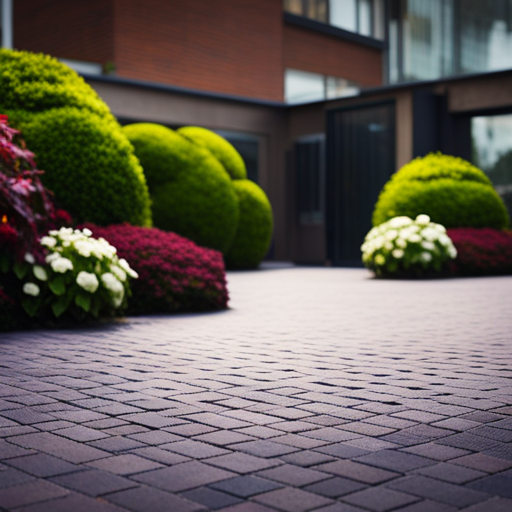Selecting the Right Underlay for Your Flooring

When it comes to flooring, the underlay is the unsung hero that holds the key to comfort, durability, and sound insulation.
Like a sturdy foundation for a towering skyscraper, the right underlay can make or break the integrity of your flooring.
In this article, we will explore the crucial factors to consider when selecting the perfect underlay for your flooring, ensuring a solid and sound investment in your home.
Importance of Underlay Selection
The choice of underlay for your flooring is a crucial decision that can significantly impact the performance and longevity of your floor. Underlay selection plays a vital role in providing support, cushioning, and noise reduction for your flooring. When selecting underlay, it’s important to consider factors such as the type of flooring, subfloor condition, and the specific requirements of the room.
For example, areas with high foot traffic may benefit from underlay with enhanced durability, while rooms where sound insulation is crucial may require underlay with sound-absorbing properties.
Proper installation of underlay is equally important to ensure optimal performance. Before installation, it’s essential to thoroughly clean and level the subfloor to prevent any imperfections from affecting the underlay and the flooring above. Additionally, ensure that the underlay is laid out uniformly, without any gaps or overlaps, to maintain consistent support and cushioning.
When joining underlay sheets, using a moisture-resistant tape can help create a seamless barrier against any moisture from the subfloor. Following these installation tips can enhance the effectiveness of the underlay and contribute to the overall quality and durability of your flooring.
Flooring Compatibility Considerations
When considering underlay options, it is imperative to evaluate the compatibility of the underlay with the specific type of flooring being installed. The success of a flooring installation heavily depends on the underlay’s ability to complement and support the flooring material. Compatibility issues can lead to premature wear and damage to the flooring, making it crucial to select an underlay that is suitable for the specific flooring type.
| Flooring Type | Underlay Type | Durability Rating |
|---|---|---|
| Hardwood | Foam or rubber | High |
| Laminate | Foam or felt | Medium |
| Carpet | Rubber or foam | High |
| Vinyl | Cork or rubber | High |
| Tile | Cork or rubber | High |
The table above illustrates the importance of choosing the right underlay based on the flooring type. Underlay durability is a critical factor in ensuring the longevity and performance of the flooring. Selecting an underlay with a durability rating that aligns with the specific demands of the flooring material will contribute to a successful and long-lasting flooring installation.
Understanding Underlay Materials
Understanding the materials used in underlay is essential for selecting the right one for your flooring. Different materials offer various benefits, and choosing the most suitable underlay material depends on the type of flooring you have.
Benefits of Different Materials
A wide range of materials are available for underlays, each offering distinct benefits for various types of flooring.
When considering cost effectiveness, foam underlays are a popular choice due to their affordability and ease of installation. Foam underlays are lightweight and simple to handle, making the installation process quicker and more straightforward, reducing labor costs. Additionally, foam underlays provide good thermal and sound insulation, enhancing the overall comfort of the flooring.
On the other hand, rubber underlays offer superior durability and resilience, making them suitable for high-traffic areas. These underlays are cost-effective in the long run as they extend the lifespan of the flooring.
Understanding the benefits of different materials is crucial in making an informed decision about the most suitable underlay for your flooring needs.
Choosing Based on Flooring
For optimal performance, it is essential to select an underlay that is compatible with the specific type of flooring and subfloor. When choosing underlay based on budget, consider the long-term savings that come with durability. Compatibility with different flooring types is crucial for a seamless installation. For example, a laminate flooring underlay should provide moisture protection and sound absorption. Here’s a table to help you understand underlay materials:
| Underlay Material | Suitable for Flooring Types | Installation Tips |
|---|---|---|
| Foam | Laminate, Engineered Wood | Easy to cut and fit |
| Rubber | Hardwood, Tile | Provides excellent support and stability |
| Felt | Carpet | Provides extra warmth and comfort |
Impact of Underlay Thickness
The thickness of underlay can significantly impact the performance and longevity of your flooring.
It plays a crucial role in reducing noise transmission, providing comfort underfoot, and improving thermal insulation.
Understanding the impact of underlay thickness on these key factors is essential in making an informed decision for your flooring needs.
Noise Reduction Benefits
When selecting the right underlay for your flooring, the impact of underlay thickness on noise reduction should be carefully considered. The thickness of the underlay plays a crucial role in enhancing the acoustic performance of the flooring and providing soundproofing options.
To understand the noise reduction benefits, consider the following:
-
Impact on Sound Transmission: Thicker underlays significantly reduce the impact of sound transmission, creating a quieter environment.
-
Improvement in Room Acoustics: A thicker underlay helps in enhancing room acoustics, reducing echoes and reverberations.
-
Noise Absorption: Thicker underlays absorb more impact noise, resulting in a quieter and more peaceful living space.
-
Enhanced Comfort: A thicker underlay not only reduces noise but also provides better cushioning underfoot, enhancing overall comfort.
Considering these factors, the underlay thickness significantly influences noise reduction and overall comfort in your living space.
Moving forward, let’s delve into the impact of underlay on flooring longevity and comfort.
Flooring Longevity and Comfort
Enhancing flooring longevity and comfort relies on selecting an underlay with an appropriate thickness to provide optimal support and cushioning. The underlay thickness directly impacts the durability of the flooring by absorbing the impact of foot traffic and reducing the risk of premature wear and tear.
Thicker underlays offer longevity benefits by acting as a protective barrier between the subfloor and the flooring material, thus extending the lifespan of the floor. Additionally, the cushioning effect of a thicker underlay enhances the comfort of the flooring, providing a softer and more supportive surface to walk on.
When considering underlay options, it’s crucial to factor in comfort considerations such as the desired level of softness and support for a more enjoyable walking experience. By carefully assessing the underlay thickness, one can effectively optimize both the longevity and comfort of their flooring.
Thermal Insulation Advantages
Selecting an appropriate underlay thickness directly impacts the thermal insulation advantages of the flooring, with thicker underlays providing enhanced insulation and energy efficiency. The impact of underlay thickness on thermal insulation is crucial for several reasons:
- Improved Energy Efficiency: Thicker underlays reduce heat loss, leading to lower energy consumption and cost savings.
- Enhanced Insulation: Thicker underlays create a more effective barrier against cold floors, improving overall insulation.
- Better Temperature Regulation: Thicker underlays help maintain a consistent temperature, reducing the need for excessive heating and cooling.
- Extended Flooring Lifespan: Improved insulation through thicker underlays can contribute to reducing the wear and tear on the flooring, leading to increased longevity.
Understanding the impact of underlay thickness on thermal insulation is essential for maximizing energy efficiency and cost savings. This makes it crucial to consider the thickness of the underlay when selecting flooring options.
Now, let’s delve into the topic of ‘sound insulation and underlay’.
Sound Insulation and Underlay
Sound insulation is a key consideration when choosing the appropriate underlay for your flooring. The underlay material plays a crucial role in reducing impact noise and airborne sound transmission, creating a quieter and more comfortable environment. Different underlay materials offer varying levels of sound insulation, making it essential to select the right one based on your specific needs. Here is a comparison of common underlay materials for sound insulation:
| Underlay Material | Sound Insulation Level |
|---|---|
| Foam | Good |
| Rubber | Excellent |
| Felt | Very Good |
| Cork | Excellent |
| Combined Materials | Varies |
As shown in the table, rubber and cork underlays provide excellent sound insulation, while foam and felt underlays offer good to very good levels. Some underlays are also made from combined materials, resulting in varying sound insulation levels. Understanding these differences can help you make an informed decision based on your specific requirements. Now, let’s delve into the next section on ‘moisture resistance and underlay’.
Moisture Resistance and Underlay
One crucial aspect to consider when selecting underlay for your flooring is the level of moisture resistance provided by the material. Proper moisture resistance not only protects your flooring but also ensures the durability of the underlay. Here are some key points to consider regarding moisture resistance and underlay:
- Material Composition: Look for underlay made from materials with inherent moisture resistance, such as rubber or closed-cell foam.
- Vapor Barrier: Consider underlay with an integrated vapor barrier to prevent moisture from seeping through to the flooring.
- Waterproof Backing: Opt for underlay with a waterproof backing to provide an extra layer of protection against moisture.
- Mold and Mildew Resistance: Choose underlay that is specifically designed to resist mold and mildew growth, especially in high-moisture areas.
By prioritizing moisture resistance and underlay durability, you can ensure that your flooring remains in top condition for longer periods. This is particularly important in areas prone to humidity and moisture.
Now, let’s delve into the next section about ‘underlay features to enhance comfort’.
Underlay Features to Enhance Comfort
When considering underlay features to enhance comfort, it is essential to prioritize cushioning and insulation to create a comfortable and inviting flooring surface. Enhanced support and moisture control are also crucial factors in enhancing the overall comfort of the flooring. Underlays with these features can significantly improve the feel and performance of your flooring, whether it’s carpet, laminate, vinyl, or engineered wood.
| Feature | Description | Benefits |
|---|---|---|
| Enhanced Support | Underlays with enhanced support provide | – Reduces foot fatigue |
| better weight distribution and | – Improves overall comfort | |
| impact absorption for a more comfortable | – Extends the life of the flooring | |
| walking experience. | ||
| Moisture Control | Underlays with moisture control | – Prevents mold and mildew growth |
| properties help to minimize moisture | – Increases the longevity of the flooring | |
| and humidity issues, creating a healthier | – Improves indoor air quality | |
| and more comfortable indoor environment. |
Selecting an underlay with these features will not only enhance the comfort of your flooring but also contribute to a healthier and more durable living space.
Frequently Asked Questions
Are There Any Specific Underlay Options for Different Types of Flooring, Such as Hardwood, Laminate, or Vinyl?
Underlay materials vary for different flooring types, including hardwood, laminate, and vinyl. Installation methods also differ based on the specific flooring material. It’s crucial to select underlay that complements the characteristics and installation requirements of each flooring type.
How Does Underlay Thickness Affect the Overall Feel and Comfort of the Flooring?
The underlay thickness significantly impacts the overall feel and comfort of the flooring. It can mitigate moisture issues, enhance soundproofing, and accommodate different flooring types. Advanced underlay technologies offer various options to cater to specific requirements.
Can Underlay Help With Soundproofing in Multi-Level Homes or Apartment Buildings?
In multi-level homes or apartment buildings, underlay can significantly contribute to soundproofing benefits. Various underlay material options such as rubber, foam, and cork can effectively reduce impact noise and airborne sound transmission.
What Are the Potential Moisture-Related Issues That Can Arise With Certain Types of Underlay, and How Can They Be Addressed?
Moisture prevention is critical in underlay selection. Certain materials can trap moisture, leading to mold and flooring damage. Choose underlays with moisture barriers and consider flooring type for impact. Regularly inspect and maintain underlay to prevent issues.
Are There Any Additional Features or Technologies in Underlay Products That Can Enhance the Overall Comfort and Performance of the Flooring?
In the realm of underlay technologies, advancements have revolutionized the landscape, offering unparalleled comfort and performance enhancements. These innovations have redefined the underlay’s role, elevating it beyond mere support to a key element in flooring satisfaction.
Conclusion
In conclusion, the selection of the right underlay for flooring is crucial for ensuring compatibility, comfort, and protection against moisture.
It is important to consider the materials, thickness, and features of the underlay to enhance the overall performance and longevity of the flooring.
Understanding the impact of underlay on sound insulation is also essential in creating a comfortable and quiet environment.
Overall, the right underlay contributes significantly to the quality and durability of the flooring.

Rubin Everest, a seasoned expert in the world of flooring, brings a wealth of knowledge and passion to the surface. As the mind behind ebbow.com, Rubin is dedicated to sharing insights on the latest trends, innovative solutions, and expert advice in the realm of flooring. Whether you’re seeking practical tips for installation or design inspiration, Rubin Everest is your go-to source for all things flooring-related, making your journey to the perfect floor an informed and enjoyable experience.





